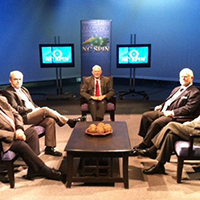My Spin: The good and bad about a single primary election
Published September 6, 2015
By Tom Campbell
by Tom Campbell, Executive Producer and Moderator, NC SPIN, September 6, 2015.
Our legislature is talking about combining both the presidential and state primary elections into one election next year. This is both good and bad for our state.
The presidential primary was moved so North Carolina might once again have a voice in selecting the nominees from both the Republican and Democratic parties. For too many years we haven’t been players in that beauty pageant and the legislature’s intent was good. But to be meaningful we had to hold the election in early March or else too many other states would have voted and it wouldn’t have been worth our while to go through the motions.
Normally, our primary elections are held in May, in anticipation of the November General Elections. There are many, myself included, who believe such a long period between primaries and the November elections forces the campaign season to be too long. But turnout in June, July or August would be even more pathetic than it is now and candidates don’t think a September primary would give them enough time to campaign. So we hold ours in May.
Let’s look at the good and the bad of one, combined primary in March.
First, the good. For starters, the taxpayers of our state will save about $6 million, the cost of staging another statewide vote. Those who tire easily from the cacophony of political ads will be pleased by the shortened time frame. Instead of enduring the often-nauseous messages starting in January and running all the way into early May, the date of the other statewide primary, they will necessarily be contained in an abbreviated time span.
Now the bad. TV and radio stations are already salivating over the 2016 political cycle. They love the idea of two primaries because it provides more opportunities for ad revenues. There is a finite amount of available ad time and broadcasters can’t completely neglect the car dealers, furniture stores and advertisers who support them throughout the year. Having only one primary will significantly restrict the ad time broadcasters can sell and, since ad rates are a supply and demand proposition, state and local candidates will find themselves in a bidding war where ad prices are so steep they are effectively shut out.
What’s wrong with less time taken up by these mean-spirited ads? Our big problem with only one primary is that we would like to see both the presidential candidates and the state candidates present themselves to voters in our state. Bad as the ads might be, they do tell us much about the candidate and provide some insight into how they would govern if elected. You better believe the big name presidential parade will garner most of the attention and media coverage. They will also suck up most of the campaign contributions, so statewide candidates, without big bankrolls and big independent expenditure groups to support them will not be able to afford airtime.
North Carolina has some pretty important elections coming up in 2016 and we want to see the candidates, hear what they have to say and form opinions without the blaring, distracting presidential circus drowning them out.
With the primary in March, voters will likely have forgotten who they voted for in March and candidates might have trouble raising necessary sums to wage a campaign come November. Of course, that could be good news. Maybe the candidates might actually have to hold public forums, go to community events and wage an old-fashioned grassroots campaign.
$6 million is a lot of money and we would like to think we could hold statewide elections cheaper. But in a state that has a $21 billion budget it is chicken feed. It the legislature would have passed the budget in June instead of lingering around until mid-September (or later) we could have saved a healthy down payment on that cost.
We say keep the two primaries separate!
September 7, 2015 at 8:56 am
Richard L Bunce says:
Better yet, eliminate the primaries and have the political parties organize and fund their own candidate selection process within their party membership for the fall general election.







